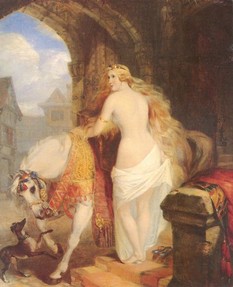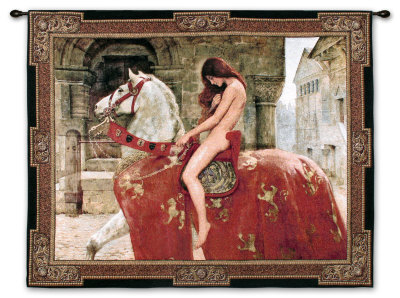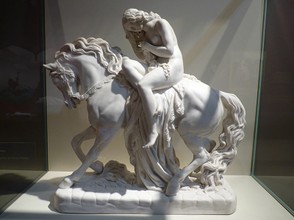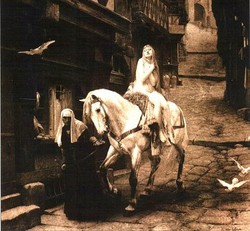 The first mention of the Godiva legend comes from the aforementioned Roger of Wendover, in his chronicle for 1057. According to Wendover's telling, Godiva pleaded with Leofric to ease the burden of taxes, and he, weary with her persistence, agreed...with the caveat that she ride naked through the streets.
The first mention of the Godiva legend comes from the aforementioned Roger of Wendover, in his chronicle for 1057. According to Wendover's telling, Godiva pleaded with Leofric to ease the burden of taxes, and he, weary with her persistence, agreed...with the caveat that she ride naked through the streets.
As you do!
Why he did this is anyone's guess. I can only assume he felt certain she wouldn't do go through with it and he, therefore, would shut her up without the need to capitulate.
Anyway, that's where Wendover leaves the tale. We don't know whether she did it or not, or, indeed, whether Leofric was jesting and lowered taxes regardless.
But as the story continued to be told, Lady Godiva shook off her embarrassment and horror (bear in mind, she was a very religious woman), and, so great was her compassion for her people, that she agreed.
Telling all of the townspeople to stay in their homes, keeping doors and windows shuttered, she stripped off and mounted her waiting horse.
Of course, there was just one fly in the ointment. Tom: the man who couldn't help himself. Temptation too great, 'peeping Tom' unbarred his window in the hopes of getting an eyeful. However, as the legend goes, he was struck blind before Godiva came into view.
Her side of the bargain complete, she returned to her husband, who agreed to ease the town's burden by ending all tolls except those on horses.
What we do know is accurate is that a subsequent inquiry showed that, during that time, sure enough, there were no tolls...except on horses.
Did Lady Godiva really ride naked through Coventry? My hunch is that she didn't. Was there really a man named Tom who went blind as he tried to catch a glimpse? I doubt it. He was only added to the story in the 17th century.
What is true is that the Godiva legend is still enthralling, and is kept alive and well in Coventry with their annual Godiva Procession, which began in 1678 and continues to this day.







 The first mention of the Godiva legend comes from the aforementioned Roger of Wendover, in his chronicle for 1057. According to Wendover's telling, Godiva pleaded with Leofric to ease the burden of taxes, and he, weary with her persistence, agreed...with the caveat that she ride naked through the streets.
The first mention of the Godiva legend comes from the aforementioned Roger of Wendover, in his chronicle for 1057. According to Wendover's telling, Godiva pleaded with Leofric to ease the burden of taxes, and he, weary with her persistence, agreed...with the caveat that she ride naked through the streets.

 How to Avoid College Debton 07/31/2014
How to Avoid College Debton 07/31/2014
 Was Charlotte Bronte Jealous of her Sister Anne?on 07/15/2014
Was Charlotte Bronte Jealous of her Sister Anne?on 07/15/2014
 Whose Side is Cancer Research UK on?on 07/06/2014
Whose Side is Cancer Research UK on?on 07/06/2014
 A Plot Summary of Electra by Sophocleson 07/05/2014
A Plot Summary of Electra by Sophocleson 07/05/2014



Comments
I have just looked up heregeld. It was a tax to pay for mercenaries to support the armed forces.
Frank
I think this may have been a royal tax, collected by the local lord.
Heregeld! The Saxons had two words for an army: a fyrd, which was a defensive force, and a here, an aggressive force. Was the here his own, or did he want to arm against a possible invader?
All the versions agree on one thing and that is that Godiva also known as Godgifu, was a virtuous and well loved noble lady. So rationally what would cause such a pious lady of rank to have this legend woven around her? What would she have done to gain such notoriety ?
It would appear that Lady Godiva, who was virtuous and charitable, performed some sort of public penance for the misdeeds of her husband, Leofric after he had raised taxes on the town's folk and refused to lower them when his wife asked him to do so.
It may be that she appeared in the town stripped of her usual badges of rank and therefore " naked " in humiliation in the eyes of the people. This could easily be mixed up the "Christian story of a naked Eve or ideas of a naked fertility goddess.
Whatever the reason, Leofric underwent some sort of public conversion after this and opened an Abbey locally. This was a major turnaround as he had tyrannised the Church and oppressively imposed the tax known as the heregeld.
I think this is a lovely tale, and I have very much enjoyed reading all the comments. And I love the Godiva chocolates!
Coventina was the goddess at Coventry. Certain goddesses were honoured through a living embodiment, a woman who represents them. This is still the case in Nepal, where a pre-pubescent girl embodies the goddess Shri until puberty. In some cults a mature woman represents the goddess, as an expression of her beauty and fertility. Why a horse? Ancient British pagan religion valued the horse as a sacred animal. Thus a goddess or her representative on a horse is to be expected.
When the Saxons came they were not interested in spreading their own faith-pagans rarely were, and like all pagan faiths there was a tendency for the various Saxon and pre-saxon cults to be conflated. Thus pre-Christian survivals at an important shrine like Coventry are to be expected, and there would have been both Saxon and British devotees.
@frankbeswick - that's a fascinating story - had no idea that Coventry dated back to Roman and pre-Roman times
Thanks so much for the update, cmoneyspinner. You're right, 'sinful' and Godiva go very well together!
@WiseFool - It's been years since I've been back to Miami so I just Googled to find out that:
- Yes! Godiva chocolates are still made and
- Yes, a friend did let me try one, many years ago. His exact description for how good they tasted was: "They are sinful!"
So the story of Godiva sort of made me laugh when I contrasted it with how my friend described the chocolates. :)
It seems the store I once knew as Burdines is now Macy, or rather Burdines-Macy's.
Wow! A lot has changed!
http://www.mystore411.com/store/view/...
Thanks Frank and Jo for brining up the possible Pagan roots of the story. That wasn't something I'd considered, but it's a very interesting thought. For me though, even if the 'naked-horse -ride' was an Ancient tradition in honour of Coventina (or another god or goddess), the fact the Godiva story has morphed and was, at first telling, very incomplete, still points to her not having really done it. But I guess we'll never know for sure, and that's part of the fascination!
Cmoneyspinner, I didn't know Godiva was also a chocolate - have you tried one since, or are they no longer made?
Hi, Abby. Thanks for stopping by and taking the time to leave a comment. Whether she really did the 'nude ride' or not, she's a captivating figure and, I think, will remain so.